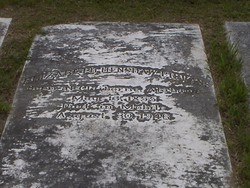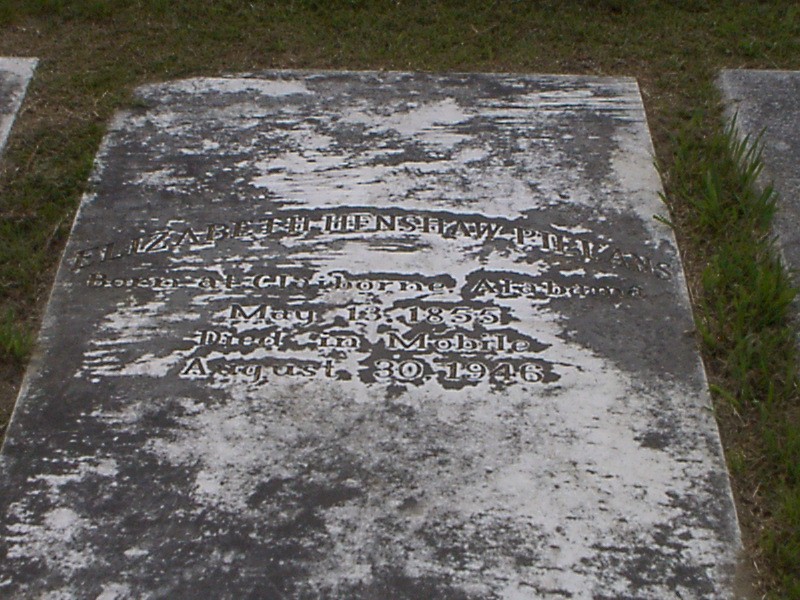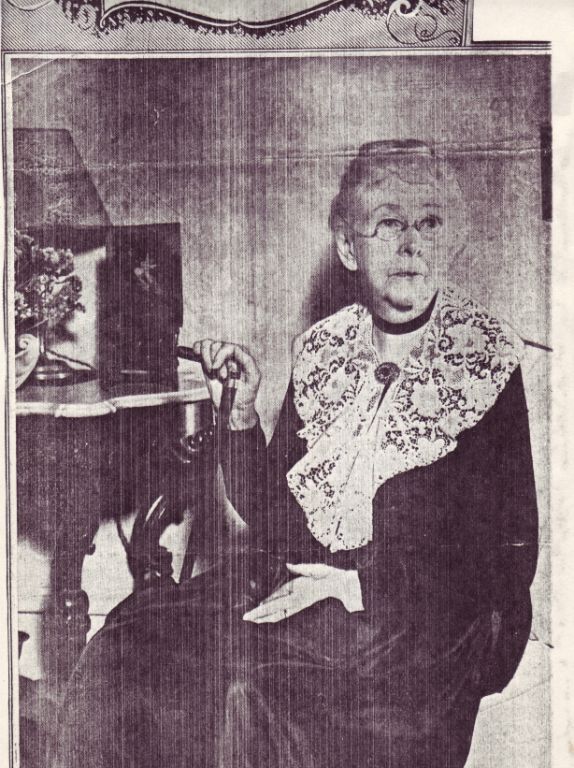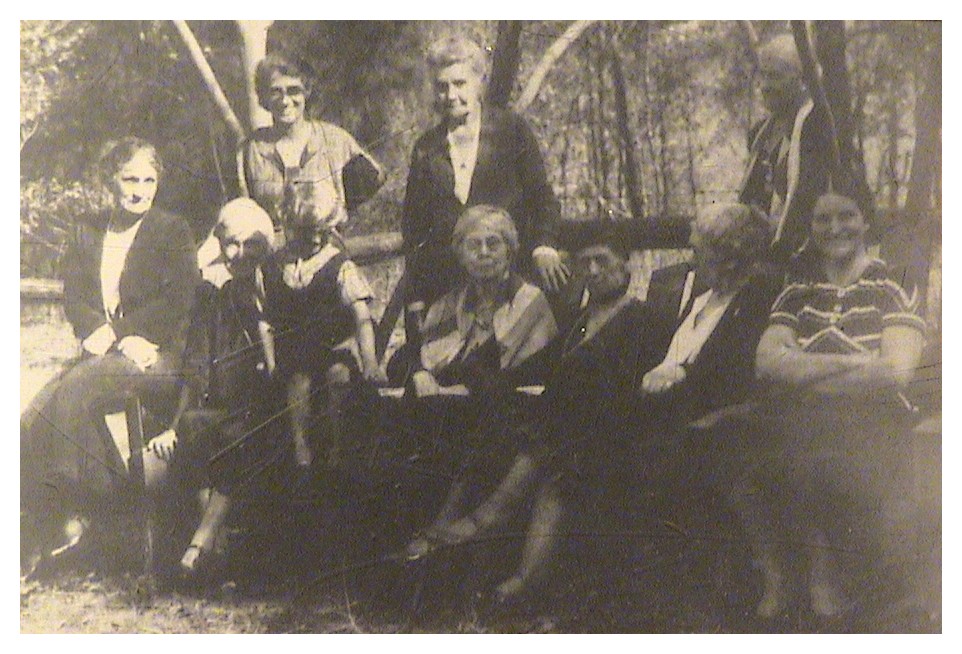Daughter of Judge Rufus Campbell Torrey and his first wife, Elizabeth Sargent Henshaw, daughter of Andrew Henshaw and Elizabeth Isbell who was the daughter of John Lewis Isbell and Ann Hannah (Anderson) Isbell.
Mrs. Torrey's brother Andrew Isbell Henshaw married his cousin Mary Anderson Isbell and had one daughter, Mary Montague Henshaw, wife of Judge Harry Toulmin. Mrs. Henshaw was widowed a few years after her brother-in-law Judge Torrey, so she and Judge Torrey married, thus Daisy's aunt Mary Isbell Henshaw became her stepmother while her first cousin Mary Montague Toulmin became her stepsister. They always called each other Sister, and after Judge Toulmin's death, "Mollie" lived 16 years with the Pillanses at 908 Government Street until her death in 1932.
Daisy Henshaw married 28 APR 1875 Harry Pillans, Mobile city commissioner and mayor. They had met at a party given by Judge Toulmin's sister, Mrs. Edmund Pendleton Gaines. Harry and Daisy lived at 50 S. Broad St. (1876-1893), southwest corner of Broad and Conti St., and in 1894 moved to 908 Government Street, a home built by his uncle Joel Abbot Roberts in 1857, sold in 1875 to Dr. Edmund P. Gaines. His aunt Mary Roberts lived next door at 910 Government Street and his parents, Palmer and Laura Roberts Pillans, lived next door at 906 Government Street. Both antebellum Pillans homes were demolished in 1979 for a fast food restaurant that was itself demolished for a drug store in 1999.
Notable Men of Alabama (1904), vol. 1, by Joel C. Dubose, p. 126: Mrs. Pillans "enjoyed a distinguished lineage, being descended from the Henshaws of Massachusetts and Isbells of Virginia."
History of Alabama and Dictionary of Alabama Biography, vol. 4 by Thomas M. and Marie Bankhead Owen, p. 1365: "Mrs. Pillans is a descendant of the Henshaws of Massachusetts and of the Isbells of Virginia, her New England ancestry running back to John Alden and his wife Priscilla."
MayMayflower Lineages:
1. Alden-Bass-Torrey
John Alden + Priscilla Mullins
Ruth Alden + John Bass
Samuel Bass* + Mary Adams
Bethia Bass** + Wm Torrey
John Torrey*** + Hannah Bean
John Torrey + Sally Richardson
Rufus C. Torrey + Elizabeth S. Henshaw
Elizabeth Henshaw Torrey + Harry Pillans
2. Alden-Bass-Henshaw
John Alden + Priscilla Mullins
Ruth Alden + John Bass
Joseph Bass* + Mary Belcher
Elizabeth Bass** + Daniel Henshaw
David Henshaw*** + Mary Sargent
Andrew Henshaw + Elizabeth Isbell
Elizabeth S. Henshaw + Rufus C. Torrey
Elizabeth Henshaw Torrey + Harry Pillans
*brother of Hannah Bass Adams
**1st cousin of Joseph Adams
*** 2nd cousin of President John Adams, father of Pres.John Quincy Adams).
A small walnut footstool once owned by John and Abigail Adams was a family heirloom passed down in the Henshaw and Torrey families and displayed in Harry and Daisy Pillans' home on Government Street in Mobile.
3. Howland-Sargent
John Howland + Eliz Tilney
Hope Howland +John Chipman
Lydia Chipman + John Sargent
Jonathan Sargent + Mary Sprague
Nathan Sargent + Mary Denny
Mary Sargent + David Henshaw
Andrew Henshaw + Elizabeth Isbell
Elizabeth S. Henshaw + Rufus C. Torrey
Elizabeth Henshaw Torrey + Harry Pillans
July 8, 1946: Byron Arnold, University of Alabama Assistant Professor of Music, brought recording equipment to Mobile and recorded Daisy Pillans singing pre-Civil War era songs, audio recordings preserved today at the Smithsonian Institute (Mobile Register, August 13, 1946, page 4-B).
AN ALABAMA SONGBOOK: BALLADS, FOLKSONGS, AND SPIRITUALS COLLECTED BY BYRON ARNOLD, edited with an introduction by Robert J. Halli Jr. (Tuscaloosa: University of Alabama Press, 2004), pp.31-32 (Laura Pillans, 3 Sept 1945), 86-87 (Laura Pillans 23, July 1947), 161-62 (Laura Pillans, 3 Sept 1945), 165-66 (Laura Pillans, 3 Sept 1945) contains music and lyrics to songs sung by Elizabeth Henshaw Pillans and Miss Laura Pillans. The dates indicate multiple visits.
Page 278: "Elizabeth Henshaw Pillans was a native of Claiborne, Alabama, and was the daughter of Rufus C. Torrey and Elizabeth Henshaw Torrey. She was married to Mr. Pillans at Claiborne on April 21, 1875, and had lived in Mobile since that time. I met her when she was ninety-one years of age. Her mind was active and alert. She was a sweet, fragile-looking lady whose singing voice, although a little weak, was still vibrant and accurate. After singing the first three songs, she became tired; her daughter, Laura Pillans, gave me the remainder with some prompting from her mother. I enjoyed my hour with her very much. She made a picture as she sat in her antique chair in the drawing room of the beautiful old home on Government Street. She died on August 30, 1946. Laura Pillans gave me the following account of her mother's recollections.
"'There was an incident she was fond of relating about something the Negroes did after the war ended. My mother's mother (Elizabeth Henshaw) lived in Virginia. When she married Judge Torrey and came to live in Alabama her father gave her a number of slaves. They had always raised tobacco in Virginia, but had to raise cotton in Alabama. They were put on a plantation a little way up the river from Claiborne where the family lived. When the war ended and they were freed, they went back to what they knew best and planted tobacco, built the slats to shade it, raised it, dried it, and cured it and so forth, and put it on a barge and sent it down the river to my grandmother with a note saying they wanted their 'Dear Mistis' to sell it, that they knew the war had left her with very little, so they raised this crop for her to help her out.
"'The family lived in a large old home with wide hall and large rooms, near their plantation in Claiborne. Mama had a little colored maid of her own and the four children had a mammy who acted as nurse and mentor. She taught them most of the old songs Mama remembered and told them many tales. My mother was ten in the last year of the war, and had very vivid recollections of the arrival of the Northern troops. First the Confederate soldiers in retreat came along the road near them. Her parents gave the Confederates all of their horses except a small white Shetland pony. Then came the Union forces, composed chiefly of hired Hessians (which may explain some of their behavior). They did not burn my mother's home because it was so well adapted for use as a hospital. The family was allowed to use two rooms, and all the rest was full of cots for the sick and wounded, of both sides, Union and Confederate. My grandmother (*Henshaw) helped with the nursing. The men were wantonly destructive and took possession of everything, but a description of their actions is not what you want. As a child she was taught petit point, to embroider, and to play the piano, as were all little girls then. But after the war she and her older brother were taken by coach to Virginia, then by train to Massachusetts where she went to school near Boston for several years. Her brother was sent to Harvard. Her father, Judge Rufus C. Torrey, came to Alabama from Massachusetts for his health when he was a young man, hence sent his children there to be educated.
"'She used to tell of how her mammy would sing them to sleep with the old songs.
"'I realize that I have given you little of the color or flavor of her life as a child, whence came the old songs; however, she said so little about that and so much and often about the experiences at the close of the war, in Massachusetts, etc. She loved to tell of the Negroes' loyalty to her parents. She said old Uncle Ben buried the family silver and refused to betray its location to the Yankees. They loved their house servants and were loved by them.' "
* *It is unclear whether she means Daisy's maternal grandmother, Elizabeth Isbell Henshaw, or her niece, Daisy's aunt and stepmother Mary Anderson Isbell Henshaw Torrey, since both lived in the Torrey home at the time and Daisy usually referred to her stepmother as "Mother," and her children referred to her as Grandmother.
Daisy's aunt/stepmother Mary Anderson Isbell Henshaw Torrey, called "Pretty Polly," was a third cousin of Mrs. Wallis Simpson, duchess of Windsor.
Daisy Pillans was a second cousin of Arthur Carey Torrey, the grandfather of Arthur Haviland Torrey whose wife Therese "Tay" Hohoff Torrey, was the editor of Harper Lee's novel, TO KILL A MOCKINGBIRD.
New Orleans Times-Picayune July 28, 1912, page 32, column 4: "MRS. WOODROW WILSON'S NEW ORLEANS KIN," by Ethel Hutson: "…The Pillans family, of Mobile, also draw their descent from one of the daughters of Job Palmer, and Mrs. (Ida Pillans) Norvell, Mrs. Edith Pillans Walker and Harry Pillans are representatives of this family who are almost as well known here as there."
The Pillanses were also related to Woodrow Wilson through the Herndons and Roberts.
Interestingly, the 1860 and 1870 censuses show Daisy Henshaw as born in Alabama, but the 1880-1940 censuses consistently show her as born in Massachusetts.
Daughter of Judge Rufus Campbell Torrey and his first wife, Elizabeth Sargent Henshaw, daughter of Andrew Henshaw and Elizabeth Isbell who was the daughter of John Lewis Isbell and Ann Hannah (Anderson) Isbell.
Mrs. Torrey's brother Andrew Isbell Henshaw married his cousin Mary Anderson Isbell and had one daughter, Mary Montague Henshaw, wife of Judge Harry Toulmin. Mrs. Henshaw was widowed a few years after her brother-in-law Judge Torrey, so she and Judge Torrey married, thus Daisy's aunt Mary Isbell Henshaw became her stepmother while her first cousin Mary Montague Toulmin became her stepsister. They always called each other Sister, and after Judge Toulmin's death, "Mollie" lived 16 years with the Pillanses at 908 Government Street until her death in 1932.
Daisy Henshaw married 28 APR 1875 Harry Pillans, Mobile city commissioner and mayor. They had met at a party given by Judge Toulmin's sister, Mrs. Edmund Pendleton Gaines. Harry and Daisy lived at 50 S. Broad St. (1876-1893), southwest corner of Broad and Conti St., and in 1894 moved to 908 Government Street, a home built by his uncle Joel Abbot Roberts in 1857, sold in 1875 to Dr. Edmund P. Gaines. His aunt Mary Roberts lived next door at 910 Government Street and his parents, Palmer and Laura Roberts Pillans, lived next door at 906 Government Street. Both antebellum Pillans homes were demolished in 1979 for a fast food restaurant that was itself demolished for a drug store in 1999.
Notable Men of Alabama (1904), vol. 1, by Joel C. Dubose, p. 126: Mrs. Pillans "enjoyed a distinguished lineage, being descended from the Henshaws of Massachusetts and Isbells of Virginia."
History of Alabama and Dictionary of Alabama Biography, vol. 4 by Thomas M. and Marie Bankhead Owen, p. 1365: "Mrs. Pillans is a descendant of the Henshaws of Massachusetts and of the Isbells of Virginia, her New England ancestry running back to John Alden and his wife Priscilla."
MayMayflower Lineages:
1. Alden-Bass-Torrey
John Alden + Priscilla Mullins
Ruth Alden + John Bass
Samuel Bass* + Mary Adams
Bethia Bass** + Wm Torrey
John Torrey*** + Hannah Bean
John Torrey + Sally Richardson
Rufus C. Torrey + Elizabeth S. Henshaw
Elizabeth Henshaw Torrey + Harry Pillans
2. Alden-Bass-Henshaw
John Alden + Priscilla Mullins
Ruth Alden + John Bass
Joseph Bass* + Mary Belcher
Elizabeth Bass** + Daniel Henshaw
David Henshaw*** + Mary Sargent
Andrew Henshaw + Elizabeth Isbell
Elizabeth S. Henshaw + Rufus C. Torrey
Elizabeth Henshaw Torrey + Harry Pillans
*brother of Hannah Bass Adams
**1st cousin of Joseph Adams
*** 2nd cousin of President John Adams, father of Pres.John Quincy Adams).
A small walnut footstool once owned by John and Abigail Adams was a family heirloom passed down in the Henshaw and Torrey families and displayed in Harry and Daisy Pillans' home on Government Street in Mobile.
3. Howland-Sargent
John Howland + Eliz Tilney
Hope Howland +John Chipman
Lydia Chipman + John Sargent
Jonathan Sargent + Mary Sprague
Nathan Sargent + Mary Denny
Mary Sargent + David Henshaw
Andrew Henshaw + Elizabeth Isbell
Elizabeth S. Henshaw + Rufus C. Torrey
Elizabeth Henshaw Torrey + Harry Pillans
July 8, 1946: Byron Arnold, University of Alabama Assistant Professor of Music, brought recording equipment to Mobile and recorded Daisy Pillans singing pre-Civil War era songs, audio recordings preserved today at the Smithsonian Institute (Mobile Register, August 13, 1946, page 4-B).
AN ALABAMA SONGBOOK: BALLADS, FOLKSONGS, AND SPIRITUALS COLLECTED BY BYRON ARNOLD, edited with an introduction by Robert J. Halli Jr. (Tuscaloosa: University of Alabama Press, 2004), pp.31-32 (Laura Pillans, 3 Sept 1945), 86-87 (Laura Pillans 23, July 1947), 161-62 (Laura Pillans, 3 Sept 1945), 165-66 (Laura Pillans, 3 Sept 1945) contains music and lyrics to songs sung by Elizabeth Henshaw Pillans and Miss Laura Pillans. The dates indicate multiple visits.
Page 278: "Elizabeth Henshaw Pillans was a native of Claiborne, Alabama, and was the daughter of Rufus C. Torrey and Elizabeth Henshaw Torrey. She was married to Mr. Pillans at Claiborne on April 21, 1875, and had lived in Mobile since that time. I met her when she was ninety-one years of age. Her mind was active and alert. She was a sweet, fragile-looking lady whose singing voice, although a little weak, was still vibrant and accurate. After singing the first three songs, she became tired; her daughter, Laura Pillans, gave me the remainder with some prompting from her mother. I enjoyed my hour with her very much. She made a picture as she sat in her antique chair in the drawing room of the beautiful old home on Government Street. She died on August 30, 1946. Laura Pillans gave me the following account of her mother's recollections.
"'There was an incident she was fond of relating about something the Negroes did after the war ended. My mother's mother (Elizabeth Henshaw) lived in Virginia. When she married Judge Torrey and came to live in Alabama her father gave her a number of slaves. They had always raised tobacco in Virginia, but had to raise cotton in Alabama. They were put on a plantation a little way up the river from Claiborne where the family lived. When the war ended and they were freed, they went back to what they knew best and planted tobacco, built the slats to shade it, raised it, dried it, and cured it and so forth, and put it on a barge and sent it down the river to my grandmother with a note saying they wanted their 'Dear Mistis' to sell it, that they knew the war had left her with very little, so they raised this crop for her to help her out.
"'The family lived in a large old home with wide hall and large rooms, near their plantation in Claiborne. Mama had a little colored maid of her own and the four children had a mammy who acted as nurse and mentor. She taught them most of the old songs Mama remembered and told them many tales. My mother was ten in the last year of the war, and had very vivid recollections of the arrival of the Northern troops. First the Confederate soldiers in retreat came along the road near them. Her parents gave the Confederates all of their horses except a small white Shetland pony. Then came the Union forces, composed chiefly of hired Hessians (which may explain some of their behavior). They did not burn my mother's home because it was so well adapted for use as a hospital. The family was allowed to use two rooms, and all the rest was full of cots for the sick and wounded, of both sides, Union and Confederate. My grandmother (*Henshaw) helped with the nursing. The men were wantonly destructive and took possession of everything, but a description of their actions is not what you want. As a child she was taught petit point, to embroider, and to play the piano, as were all little girls then. But after the war she and her older brother were taken by coach to Virginia, then by train to Massachusetts where she went to school near Boston for several years. Her brother was sent to Harvard. Her father, Judge Rufus C. Torrey, came to Alabama from Massachusetts for his health when he was a young man, hence sent his children there to be educated.
"'She used to tell of how her mammy would sing them to sleep with the old songs.
"'I realize that I have given you little of the color or flavor of her life as a child, whence came the old songs; however, she said so little about that and so much and often about the experiences at the close of the war, in Massachusetts, etc. She loved to tell of the Negroes' loyalty to her parents. She said old Uncle Ben buried the family silver and refused to betray its location to the Yankees. They loved their house servants and were loved by them.' "
* *It is unclear whether she means Daisy's maternal grandmother, Elizabeth Isbell Henshaw, or her niece, Daisy's aunt and stepmother Mary Anderson Isbell Henshaw Torrey, since both lived in the Torrey home at the time and Daisy usually referred to her stepmother as "Mother," and her children referred to her as Grandmother.
Daisy's aunt/stepmother Mary Anderson Isbell Henshaw Torrey, called "Pretty Polly," was a third cousin of Mrs. Wallis Simpson, duchess of Windsor.
Daisy Pillans was a second cousin of Arthur Carey Torrey, the grandfather of Arthur Haviland Torrey whose wife Therese "Tay" Hohoff Torrey, was the editor of Harper Lee's novel, TO KILL A MOCKINGBIRD.
New Orleans Times-Picayune July 28, 1912, page 32, column 4: "MRS. WOODROW WILSON'S NEW ORLEANS KIN," by Ethel Hutson: "…The Pillans family, of Mobile, also draw their descent from one of the daughters of Job Palmer, and Mrs. (Ida Pillans) Norvell, Mrs. Edith Pillans Walker and Harry Pillans are representatives of this family who are almost as well known here as there."
The Pillanses were also related to Woodrow Wilson through the Herndons and Roberts.
Interestingly, the 1860 and 1870 censuses show Daisy Henshaw as born in Alabama, but the 1880-1940 censuses consistently show her as born in Massachusetts.
Family Members
Sponsored by Ancestry
Advertisement
Explore more
Sponsored by Ancestry
Advertisement
















